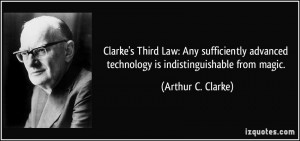
Here are a few phrases that probably sound very familiar to you if you’re interested in digital health as a marketer or a communicator. I’ve spent this week at a conference, where I listened a lot. Not only to a lot of brilliant leaders, but also to many people who were clearly still learning. And it got me thinking about what the current table stakes are. What are the concepts we’re talking about – or the ones we hope people are talking about?
A “words of the year” short list:
- Value-based care; pricing pressures
- Mobile; geofencing; beacons
- IoT; AI; machine learning; voice-activated AI; VR and AR
- Disintermediating; AAS
- Data; analytics; predictive analytics
- Agile methodology; iteration
You’ve probably heard Arthur C. Clarke’s third law, “Any sufficiently advanced technology is indistinguishable from magic.”
Well:
- Today we can know what someone will do before they do it.
- Today we can make things happen just by speaking.
- Today we can know exactly where people are and what they’re doing without being there.
- Today we can teach inanimate objects.
Harry Potter would feel right at home, wouldn’t he? Some of it still feels startling, and some of it isn’t even widely available yet. But we already take plenty of this tech for granted. It’s already seamlessly integrated itself into our everyday. We adapt very rapidly to tech – at least, tech that does its job well.
If you’re not familiar with all of these terms, here’s your primer: a quick and dirty explanation of each (not alphabetical in order to keep them organized more by concept):
- Value-based care – doctors being paid by insurance companies not for how many patients they see but how much they improve their patients; and, in a ripple effect, pharma companies measuring success not by how many drugs they sell but by how much their products (and – this is key – and their services) can improve patients’ health
- Pricing pressures – everybody is done with hearing about drugs that cost patients five and six figures a year; plus, in an an election year, it’s a particularly logical target for anyone looking for votes; particularly after issues recently with egregious pricing by companies like Mylan, Turing and Valeant.
- Mobile – put simply: we all live on our phones but companies don’t know how to handle that yet.
- Geofencing – the mobile technology which serves mobile devices in specific areas; anything from a city to a neighborhood to a building
- Beacons – same idea as geofencing but more geographically specific: think a room or an aisle
- IoT – the Internet of Things; the way everything from your phone to your car to your toothbrush to your scale is computerized and can, increasingly, talk to each other
- AI – artificial intelligence; the ability of those computerized gizmos to tell you useful things
- Machine learning – similar; the ability of those gizmos to not only tell you things but to understand what happens and adjust what it says accordingly
- Voice-activated AI – interfaces we don’t have to type into don’t just feel more futuristic; they’re faster, more efficient and can be used in a lot more situations
- VR and AR – virtual reality (glasses that put you in a completely created environment) and augmented reality (tools like glasses or your phone camera that overlay visuals on your real environment) are right on top of that metaphoric tipping point between being wildly innovative and actually practical; largely, IMO, because of Google Cardboard
- Disintermediating – taking corporations out from between the person who wants a thing and the person who gives them a thing; think Uber, Airbnb, Etsy
- AAS – as a service; the idea of selling access to stuff rather than stuff; born in software, think of how we buy cloud-based
- subscriptions instead of CD-ROMs (or stream music or movies)
- Data – and its pretentious older sister “Big Data”; basically, when we live our lives surrounded by the gizmos, an increasing percentage of everything we do creates a digital footprint, which can be saved…
- Analytics – and graphed and charted…
- Predictive analytics – …and used to not only know what someone has been done, or even what they are doing, but what they are most likely to do
- Agile methodology – super-hip way to get things done; born in software, it’s the idea of checking in quickly and regularly with the rest of a team and creating “stuff” that is put out, tested, tweaked, put out again
- Iteration – key to agile; the idea that you’re not working to create A Done Thing; you’re working to create something that works (a minimum viable product), put it out in the world, see how it works, tweak, repeat; this may look especially familiar to regular readers of this blog who notice that I polish and polish and polish
If you’d add or subtract or edit any of my list, let me know. But you’ll notice that this is a list of primarily tech-related terms. This isn’t all that we should be thinking about.
Ideas like content marketing and storytelling, concepts like empathy and humanity – those are on another short list for me.
That’s the list of reasons why all this tech matters.
I love all of this – the nerdy and the emotional, the tech and the narrative. I love the interplay. I love seeing how it’s put into practice and seeing it done right. I love putting it into practice and doing it right.
So perhaps this is really, at the end of the day, simply a list of stuff that’s exciting to me.

